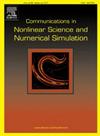陀螺弹性结构动力学建模中的几何非线性
IF 3.8
2区 数学
Q1 MATHEMATICS, APPLIED
Communications in Nonlinear Science and Numerical Simulation
Pub Date : 2025-07-19
DOI:10.1016/j.cnsns.2025.109148
引用次数: 0
摘要
大型柔性空间结构(如空间太阳能电站和超大孔径天线)是未来关键的空间基础设施,其中控制力矩陀螺仪(CMGs)可作为姿态控制、振动抑制和形状调节的专用执行器。耦合的cmg -柔性结构系统,被称为陀螺弹性结构,目前缺乏对重大变形的全面建模。本研究通过将浮动参考框架公式(FFRF)和凯恩方法的协同集成,结合柔性板的高阶应变-变形关系,开发了几何非线性动态模型,解决了这一差距。通过与商业有限元软件在大变形条件下的对比分析,验证了该模型的有效性。系统模拟揭示了cmg对三个关键结构特性的影响:(1)挠度模式,(2)振动衰减特性和(3)基频移。Sobol全局敏感性分析量化了角速度主导几何非线性,解释了总方差的99.8%(变形)和99.9%(频率)。在此基础上,建立了以角速度为目标变量的二阶多项式函数的双准则框架。对比分析表明,基于变形的准则具有较高的灵敏度,在旋翼弹性结构非线性评价中具有优先地位。本文章由计算机程序翻译,如有差异,请以英文原文为准。
Geometric nonlinearity in dynamic modeling of gyroelastic structure
Large-scale flexible space structures (e.g., space solar power stations and ultra-large aperture antennas) represent critical future space infrastructure, where control moment gyroscopes (CMGs) serve as specialized actuators for attitude control, vibration suppression, and shape regulation. The coupled CMG-flexible structure systems, termed gyroelastic structures, currently lack comprehensive modeling of significant deformations. This study addresses this gap by developing a geometrically nonlinear dynamic model through synergistic integration of the floating frame of reference formulation (FFRF) and Kane’s method, incorporating higher-order strain-deformation relationships in flexible plates. The model’s validity is rigorously demonstrated through comparative analysis with commercial finite element software under large deformation conditions. Systematic simulations reveal CMG-induced effects on three key structural characteristics: (1) deflection patterns, (2) vibration attenuation properties, and (3) fundamental frequency shifts. Sobol global sensitivity analysis quantifies that angular velocity dominates geometric nonlinearity, explaining 99.8% (deformation) and 99.9% (frequency) of total variance. A novel dual-criterion framework employing second-order polynomial functions with angular velocity as the target variable is established based on these findings. Comparative evaluation demonstrates the deformation-based criterion’s superior sensitivity, recommending its priority in nonlinearity assessment for gyroelastic structures.
求助全文
通过发布文献求助,成功后即可免费获取论文全文。
去求助
来源期刊

Communications in Nonlinear Science and Numerical Simulation
MATHEMATICS, APPLIED-MATHEMATICS, INTERDISCIPLINARY APPLICATIONS
CiteScore
6.80
自引率
7.70%
发文量
378
审稿时长
78 days
期刊介绍:
The journal publishes original research findings on experimental observation, mathematical modeling, theoretical analysis and numerical simulation, for more accurate description, better prediction or novel application, of nonlinear phenomena in science and engineering. It offers a venue for researchers to make rapid exchange of ideas and techniques in nonlinear science and complexity.
The submission of manuscripts with cross-disciplinary approaches in nonlinear science and complexity is particularly encouraged.
Topics of interest:
Nonlinear differential or delay equations, Lie group analysis and asymptotic methods, Discontinuous systems, Fractals, Fractional calculus and dynamics, Nonlinear effects in quantum mechanics, Nonlinear stochastic processes, Experimental nonlinear science, Time-series and signal analysis, Computational methods and simulations in nonlinear science and engineering, Control of dynamical systems, Synchronization, Lyapunov analysis, High-dimensional chaos and turbulence, Chaos in Hamiltonian systems, Integrable systems and solitons, Collective behavior in many-body systems, Biological physics and networks, Nonlinear mechanical systems, Complex systems and complexity.
No length limitation for contributions is set, but only concisely written manuscripts are published. Brief papers are published on the basis of Rapid Communications. Discussions of previously published papers are welcome.
 求助内容:
求助内容: 应助结果提醒方式:
应助结果提醒方式:


